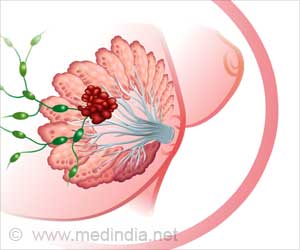- The underlying molecular mechanism involved in cancer metastasis has been discovered
- It involves a cell surface chemokine receptor called CCR7 that helps in cell signaling
- Potential drug molecules have been identified that block CCR7
- This could result in an effective therapy for cancer by preventing metastasis
The study, published in the journal Cell, was led by Dr. Jörg Standfuss, PhD, who is the Group Leader of the Laboratory of Biomolecular Research at the Paul Scherrer Institute in Villigen, Switzerland.
The lead author of the paper was Dr. Steffen Brünle, PhD, who is a Postdoctoral Fellow in the Laboratory of Biomolecular Research, working under Standfuss.
Read More..
What is the Molecular Basis of Metastasis?
The process of spreading of cancer cells from the primary site of development to distant secondary sites elsewhere in the body is termed as metastasis. Once metastasis occurs, it kills almost 90 percent of cancer patients. Metastatic cancer cells often spread through the lymphatic vessels, which are similar to blood vessels and form an elaborate network throughout the body.The cells of the lymphoid tissues express a membrane protein known as C-C Chemokine Receptor Type 7 (CCR7) on their surface. CCR7 is involved in signal transduction, meaning that it transfers external signals to the interior of the cell.
There are over 20 different chemokine receptors in the cells of all vertebrates that are capable of interacting with over 40 chemokines, which are signaling proteins. Each chemokine binds to its specific cell surface receptor and triggers the signaling cascade that delivers the external signals to the interior of the cell. This elicits a specific cellular response to the signal.
CCR7 is an important cell surface chemokine receptor that is responsible for cell movement within the body. Upon binding of the specific chemokine to CCR7 on the cell membrane, a chain reaction is set into motion which causes the cell to migrate in the direction of the highest concentration of the chemokine. This mechanism is involved in the migration of lymphocytes (cells of the immune system) to various lymph nodes located throughout the lymphatic system.
This same mechanism can be exploited by cancer cells to migrate to other parts of the body during the process of metastasis, so that they form tumors at distant secondary sites.
How was the Structure of CCR7 Deciphered?
The structure of CCR7 was deciphered through a joint collaborative effort between researchers at the Paul Scherrer Institute and F. Hoffmann-La Roche. This laid the foundation for developing a drug that could potentially prevent metastatic spread of cancer cells in certain types of cancer such as colorectal cancer.The methodology utilized by the researchers to decipher the structure of CCR7 involved X-ray crystallography at the Swiss Light Source located at the Paul Scherrer Institute.
Deciphering the structure of CCR7 was vital for initiating efforts to identify a suitable CCR7 inhibitor.
“The right molecule can prevent the signaling protein from coupling to the receptor and causing a reaction in the cell”, explains Brünle.
“Deciphering the structure of the receptor was a real challenge. The difficult thing about it was producing them, in the first place, in such a way that we could examine them with X-ray crystallography”, says Standfuss, co-leader of the Time-Resolved Crystallography Research Group at the Paul Scherrer Institute.
In order to expedite the research, F. Hoffmann-La Roche developed protein-modifying technology modules, known as crystallization chaperones.
How was the CCR7 Inhibitor Identified?
Deciphering the structure of CCR7 enabled the researchers to quickly indentify a suitable inhibitor that blocked the receptor, thereby preventing the initiation of the signaling cascade.“Our experiments show that the artificial molecule, inside the cell, binds to the receptor. This keeps the chain reaction that leads to cell migration from getting started”, Brünle says.
Search for the ideal inhibitor involved screening millions of potential drug molecules deposited in the database at F. Hoffmann-La Roche. X-ray crystallographic data of the drug-bound receptor, coupled with computer simulation, enabled the identification of the best-fitting molecule that could act as an inhibitor of CCR7. In fact, five such molecules were identified, which are being taken forward for further development as potential anticancer drugs.
Future Prospects of the New Discovery
This discovery will facilitate the development of a new class of anticancer drugs that are capable of preventing metastasis. In fact, one of the potential drug candidates has already entered human clinical trials, which means that a new drug against cancer metastasis could soon be available.Reference:
- Structural Basis for Allosteric Ligand Recognition in the Human CC Chemokine Receptor 7 - (http://dx.doi.org/10.1016/j.cell.2019.07.028)
Source-Medindia











